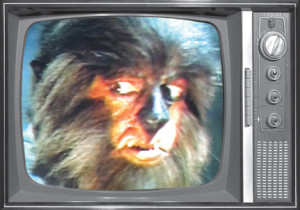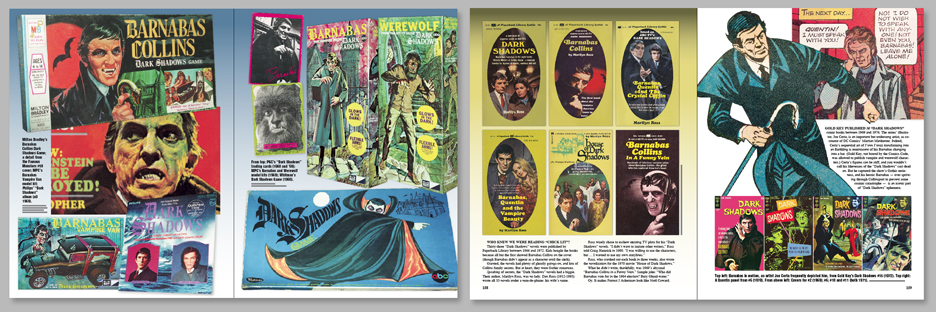From “Monster Mash: The Creepy, Kooky Monster Craze in America 1957-1972” (TwoMorrows Publishing) by Mark Voger
![Milton Bradley’s Barnabas Collins Dark Shadows Game (1969). [© Dan Curtis Productions]](https://markvoger.com/wp-content/uploads/2015/03/MVCOM-DS-GAME1.jpg)

I was one of those kids who tore home from school to watch the monsterific soap opera “Dark Shadows.” (I was so obsessed with not missing a moment, I often caught the last minute or two of the preceding soap, “General Hospital,” and began following those storylines a bit as well. I remember a doctor and a nurse were secretly in love.) The “Dark Shadows” section in “Monster Mash” presents interviews with series creator Dan Curtis and 12 cast members. Following are short excerpts from interviews with Jonathan Frid (Barnabas), Kathryn Leigh Scott (Josette), Lara Parker (Angelique) and David Selby (Quentin).
![Gold Key's Dark Shadows #2 (1969). [© Dan Curtis Productions]](https://markvoger.com/wp-content/uploads/2015/03/MVCOM-DS-COMIC.jpg)
Though not at first.
When “Dark Shadows” debuted on June 27, 1966, it was different from an average daytime drama, if still a far cry from the monster rally it would become. Initially broadcast in black and white, “Dark Shadows” began as a soap infused with mystery, as young Victoria Winters (Alexandra Moltke) took a job as a governess at Collinwood, ancestral home of the crusty, old-money Collins clan.
When series creator Dan Curtis introduced the show’s first supernatural storylines — the ghost of Josette (Episode 70, Sept. 30, 1966) and the flame-engulfed phoenix Laura Collins (Episode 191, March 30, 1967) — he saw a bounce in the ratings.
![A “Dark Shadows” trading card from PGC. This one is from Series 1 (1968). [© Dan Curtis Productions]](https://markvoger.com/wp-content/uploads/2015/03/MVCOM-DS-CARD-1-212x300.jpg)
It all led to the introduction of 18th-century gentleman vampire Barnabas Collins on April 18, 1967. The casting of Canadian actor Jonathan Frid — handsome in an odd way, and a little bit sad — was pure kismet, a perfect pairing of player and role. Barnabas was no wild-eyed bloodsucker; he was a reluctant vampire who regretted his kills and was capable of feeling love.
With his black-onyx forefinger ring, silver wolf’s-head cane and strandy hairdo, Barnabas became a cult figure — and Frid became something of a teen idol. Kids ran home from school to watch Barnabas’ daily exploits, and those of his fellow freaky denizens of Collinwood: the rotting hand of Count Petofi … the living head of Judah Zachary … the Jekyll-and-Hyde machinations of Cyrus Longworth and John Yaeger … Adam, the Frankensteinian creation of Dr. Lang … Eve, Adam’s “Bride of Frankenstein.”
![Paperback Library's novel "Dark Shadows" by, ahem, "Marilyn Ross" (1968). [© Dan Curtis Productions]](https://markvoger.com/wp-content/uploads/2015/03/MVCOM-DS-BOOK-181x300.jpg)
You could learn a few things by watching “Dark Shadows.” Who knew that Barnabas walling up Reverend Trask with brick and mortar was a literary allusion to Edgar Allan Poe’s “The Cask of Amontillado”? (Actually, back then, who knew what a “literary allusion” was?) The show challenged the laws of physics with its penchant for time-tripping. Storylines were set in 1795, 1897, the contemporary 1960s, the future and parallel time.
The mad monster party ended with the final episode on April 2, 1971. But we still haven’t seen the last of Barnabas Collins and “Dark Shadows.”
![Barnabas in motion, as artist Joe Certa frequently depicted him, from Gold Key’s Dark Shadows #15 (1972). [© Dan Curtis Productions]](https://markvoger.com/wp-content/uploads/2015/03/MVCOM-DS-PANEL-300x295.jpg)
![Kathryn Leigh Scott bares fangs at Widow's Hill. [© Dan Curtis Productions]](https://markvoger.com/wp-content/uploads/2015/03/MVCOM-DS-JOSETTE-300x220.jpg)
![Lara Parker as Angelique stands by a favorite piece of art. "My eyes were my gift." [© Dan Curtis Productions]](https://markvoger.com/wp-content/uploads/2015/03/Mark-Voger-Angelique-255x300.png)
“The problem with the incantations is that they were hard to learn, because they were just a bunch of words that weren’t really connected to anything. ‘I call on the powers of darkness to …’ so on and so on.
“A lot of times, I ended up reading them off the teleprompter. You would see my eyes dart over to the side and then back to the lens,” Parker added with a laugh.
![A 1970 Quentin panel from Gold Key's Dark Shadows comic book. Art: Joe Certa. [© Dan Curtis Productions]](https://markvoger.com/wp-content/uploads/2015/03/MVCOM-DS-QUENTIN-300x289.jpg)
“But it all worked out for the better. I think the character fit right in there with Jonathan (Frid, who played Barnabas). Quentin was younger than Louie Edmonds and Jonathan and Joan Bennett, and he was a male figure that could play off of Kathryn Scott’s character; Lara Parker’s Angelique; Beth, the character that was brought in by Kate Jackson. He could play off of all of those young ladies that came through. And of course, I was delighted to be able to do it.”
“Monster Mash” also spotlights “Dark Shadows”-related memorabilia and print products such as Paperback Library’s series of novels written by, ahem, “Marilyn Ross,” and Gold Key’s comic books illustrated by Joe Certa (co-creator of the DC Comics’ character Martian Manhunter).

